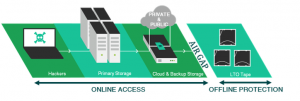By Kevin Benitez

Data is quickly becoming a critical asset to more and more companies, and now those companies are looking for ways to store massive amounts of data for long periods of time at a low cost for digital preservation or archiving.
Today, large amounts of archived data are being stored in object storage at an ever-increasing rate, both on-premise and in remote data centers such as the cloud. Object storage has been particularly attractive for storing large amounts of digital information because of its flat architecture and easy access to metadata that allows for easy indexing, finding, and using of digital content. Additionally, object stores can scale to hundreds of petabytes in a single namespace without any performance degradation.
With those needs in mind, Fujifilm has developed the FUJIFILM Object Archive, which allows object storage to be written and read to and from data tape instead of mainstream HDDs, thereby significantly reducing costs. FUJIFILM Object Archive uses OTFormat to leverage object storage and modern tape. The software uses an industry-standard S3-compatible API so that on-premises object storage can be used at a lower cost while maintaining the same operability as cloud storage.
Why is tape and object storage necessary? For starters…
Unlike file or block storage, object storage allows for scalability to Exabyte and beyond. While file storage can hold many millions of files, you will eventually hit a ceiling. Furthermore, if data needs to be shared, object storage is known for its compatibility in the cloud, providing the ability to readily share data. Adding more capacity to your object storage can be as simple as adding a tape to your tape library; remember tape adds capacity by adding media while HDDs add capacity by adding drives. Unlike other storage options, an archive can easily add storage capacity and cache to scale to petabytes and exabytes.
By storing your object storage on tape, you can create offline/offsite copies of your data, which is vital for disaster recovery and preventing ransomware attacks. When data is stored offline, it is protected by an air-gap, making it inaccessible to unauthorized access.

By leveraging the latest advances in tape technology and object storage, organizations can reduce costs for object storage by 80% or more. Organizations achieve these cost savings by creating an archive for long-term data, thus freeing up valuable space on expensive primary storage. By operating a tape library capable of multi-petabyte scale storage, data can be stored at a very low cost that is unobtainable with conventional HDDs.
Today, more and more organizations are asking – ‘What if I need to change cloud providers or get all my data back?” Or “How can I easily adhere to the best practice of storing three copies of data on two different media, one offsite, and one offline?” Creating a combination of tape and cloud storage (Hybrid Cloud Storage) could effectively combat these common challenges.
As we know, tape storage is effective for storing mission-critical data that cannot be stored in a cloud environment, or for storing large amounts of data that would be more expensive to store and retrieve from the cloud. Object Archive allows you to create an archive so that you can free up valuable space on costly primary storage – while still storing all of your organization’s data online. Moving cold data to an archive allows you to balance speed of data access with the cost of storage.
FUJIFILM Object Archive software makes hybrid cloud storage, cold data archiving, and increased data security environments a reality for object storage by enabling S3-compatible API and modern tape. Now data centers can improve scalability, security and decrease costs. Visit our webpage to learn more.
